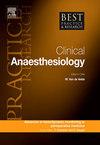你能做到多低:在大手术和生理诱因下的限制性输血策略
IF 2.8
3区 医学
Q1 ANESTHESIOLOGY
Best Practice & Research-Clinical Anaesthesiology
Pub Date : 2023-12-01
DOI:10.1016/j.bpa.2023.11.005
引用次数: 0
摘要
贫血和红细胞输注与不良后果有关。大型随机试验表明,限制性输血策略可以安全地减少患者输血暴露,形成患者血液管理的基础支柱。在这些试验中,不同人群的限制性输血阈值从7到8 g/dL不等,这种差异反映在最近关于输血触发因素的指南建议中。这种可变性意味着不同人群对于最佳结果的输血阈值存在异质性。个体差异(对贫血的耐受性、组织缺氧的风险、红细胞输血的风险)尚未在基于人群的试验中得到解决,这支持了“生理输血触发因素”表明器官灌注不足的论点。然而,生理触发仅在小型可行性试验中进行了评估,没有令人信服的结果数据。本综述总结了近期输血试验和输血指南的数据,并综述了可能的生理触发因素,这些因素可以进一步完善输血实践,最大限度地降低组织缺氧和不良后果的风险。本文章由计算机程序翻译,如有差异,请以英文原文为准。
How low can you go: Restrictive transfusion strategies in major surgery and physiological triggers
Anemia and red blood cell transfusion are associated with adverse outcomes. Large randomized trials have demonstrated that restrictive transfusion strategies can safely reduce patient exposure to transfusion, forming a foundational pillar of patient blood management. The restrictive transfusion thresholds in these trials ranged from 7 to 8 g/dL for different populations and this variability is reflected in recent guideline recommendations for transfusion triggers. Such variability implies heterogeneity among populations with respect to the transfusion threshold for optimal outcomes. Individual variability (tolerance to anemia, risk of tissue hypoxia, risk of red blood cell transfusion) has not been addressed by population-based trials, supporting the argument for ‘physiological transfusion triggers’ indicative of inadequate organ perfusion. However, physiological triggers have only been assessed in small feasibility trials without convincing outcome data. This review summarizes data from recent transfusion trials and transfusion guidelines, and reviews potential physiological triggers which could further refine transfusion practices and minimize risks of tissue hypoxia and adverse outcomes.
求助全文
通过发布文献求助,成功后即可免费获取论文全文。
去求助
来源期刊

Best Practice & Research-Clinical Anaesthesiology
ANESTHESIOLOGY-
自引率
0.00%
发文量
37
审稿时长
36 days
 求助内容:
求助内容: 应助结果提醒方式:
应助结果提醒方式:


